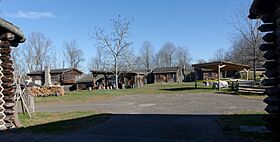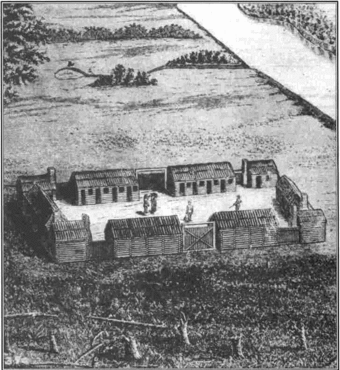Fort Boonesborough State Park facts for kids
Quick facts for kids Fort Boonesborough State Park |
|
|---|---|

The park's reproduction of Fort Boonesborough
|
|
| Lua error in Module:Location_map at line 420: attempt to index field 'wikibase' (a nil value). | |
| Type | Kentucky state park |
| Location | Madison County, Kentucky, United States |
| Area | 153 acres (62 ha) |
| Established | June 14, 1963 |
| Administered by | Kentucky Department of Parks |
|
Fort Boonesborough Townsite Historic District
|
|

Fort Boonesborough
|
|
| Nearest city | Richmond, Kentucky / Winchester, Kentucky |
| Area | 352 acres (142 ha) (NR-listed area) 1.8 acres (0.73 ha) (NHL area) |
| Built | 1775 |
| Architect | Richard Henderson Daniel Boone |
| NRHP reference No. | 94000303 |
| Significant dates | |
| Added to NRHP | April 14, 1994 |
| Designated NHL | June 19, 1996 |
Fort Boonesborough was an important frontier fort in Kentucky. It was founded by Daniel Boone and his group on April 1, 1775. They built it after crossing the Kentucky River. The settlement they created, called Boonesborough, Kentucky, was the second oldest European-American settlement in Kentucky.
This fort was a key outpost during the American Revolutionary War. It remained active into the early 1800s before people eventually left it. Today, it is a National Historic Landmark and part of Fort Boonesborough State Park. The site is one of the best-preserved places showing how early British colonists moved west. You can find it in Madison County, Kentucky, off Kentucky Route 627.
Contents
What is Fort Boonesborough State Park?
Fort Boonesborough State Park is located southeast of Lexington, Kentucky. It sits on the west bank of the Kentucky River in a rural part of Madison County. The park has a recreated version of Fort Boonesborough. This means it's a new fort built to look exactly like the old one.
Experience Pioneer Life at the Fort
The recreated fort is like a working museum. It has cabins, bunkhouses, and furniture from the past. The park offers fun history programs with the Fort Boonesborough Foundation. During certain seasons, you can see real artisans at work. These might be blacksmiths or potters. They show visitors what pioneer life was like in Kentucky long ago.
Explore the Kentucky River Museum
Inside the park, you'll also find the Kentucky River Museum. It's located in what used to be the home of a lock operator. The museum teaches you how the river affected local families and businesses. It also shares stories about the locks and dams from the 1900s.
The History of Fort Boonesborough
Long before European settlers arrived, Native Americans lived in the Fort Boonesborough area. A small village of Fort Ancient people lived there around 1400 AD.
How the Fort Was Founded
Daniel Boone first explored the Kentucky area in 1769. Later, a man named Richard Henderson tried to start a settlement there. Henderson hired Boone to create a road into the territory. Boone and his team arrived near this spot in early April 1775. Henderson followed soon after. He then oversaw the building of Boonesborough and its strong walls.
Early Government and Growth
The first form of representative government in Kentucky happened here in May 1775. By that summer, Boonesborough had 26 one-story log cabins. It also had four blockhouses, which were small, strong forts.
The Great Siege of Boonesborough
The fort saw a lot of action during the western part of the American Revolutionary War. In September 1778, the fort was attacked by American Indians. This event is now known as "The Great Siege." The people inside the fort bravely defended it.
After the War and Modern Discovery
After the war, Boonesborough became a stop for settlers moving west. It also became a key place for the growing tobacco trade. By 1820, the fort was no longer as important. Eventually, people left the area.
Archaeologists didn't fully explore the site until the 1980s. They found many important things. These included Daniel Boone's first station and the main Fort Boonesborough walls. They also found several water springs and the remains of old tobacco warehouses. The ancient Fort Ancient village site was also discovered.
Becoming a Historic Landmark
Most of the park was added to the National Register of Historic Places in 1994. This recognized it as an important archaeological historic district. The actual site of Fort Boonesborough was named a National Historic Landmark in 1996.
Images for kids
See also


